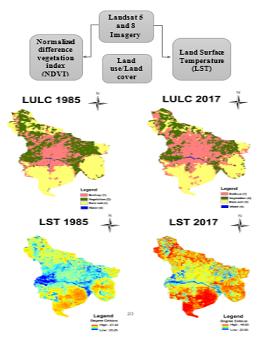Document Type : ORIGINAL RESEARCH ARTICLE
Authors
1 Department of Environmental Sciences, Faculty of Natural Resources, University of Kurdistan, Sanandaj, Iran
2 Department of Environmental Sciences, Isfahan (Khorasgan) Branch, Islamic Azad University, Isfahan, Iran
3 Renewable Energy and Energy Efficiency Group, Department of Infrastructure Engineering, Melbourne School of Engineering, The University of Melbourne, VIC 3010, Australia
Abstract
Cities are experiencing rapid population growth and consequently extensive urbanization. Land-use/land-cover change is one of the important elements worldwide, which significantly affect the environment. This study aims to describe the emergence of urban heat and cool islands as a result of changes in land-use/land-cover. Land surface temperature over a 32-year period in Isfahan city, Iran was retrieved. The results confirmed the effect of land-use/land-cover change on Landsat land surface temperature. The average land surface temperature changed from 37.5°C in 1985 to 42.7°C in 2017 during August. The highest land surface temperature in the study area for both years occurred on bare soils (40.66°C in 1985 and 45.88°C in 2017). The second highest Landsat land surface temperature was recorded in central parts of the city with dense built-up covers (36.93°C in 1985 vs 42.45°C in 2017). The central parts of the city were found to have a lower Landsat land surface temperature compared to bare soils, which contributes to the formation of urban cool islands. As expected, water bodies and vegetation had a lower Landsat land surface temperature compared to other land covers. The results also showed changes in land use types during 1985 and 2017, with an increase in water bodies (148.82%) and built-up areas (39.67%) and a decrease in vegetation (20.08%) and bare soil (12.42%). The areas converted from vegetation to built-up experienced an increase in Landsat land surface temperature, which confirmed the effect of land-use/land-cover on microclimate.
Graphical Abstract
Highlights
- LULC and consequently LST had experienced extensive alterations in a 32-year period in Isfahan, Iran;
- This study confirmed the decreasing effect of vegetation and the increasing effect of built-up areas on LST variations, which are also emphasized in other studies;
- Increase of Zayandehrud water content resulted in cool temperature in some parts of the city in 2017 compared to 1985;
- Urban green areas significantly reduced the urban temperature through evaporative cooling. Therefore, urban centers experienced a lower temperature compared to the surrounding bare lands.
Keywords



Letters to Editor
[1] Letters that include statements of statistics, facts, research, or theories should include appropriate references, although more than three are discouraged.
[2] Letters that are personal attacks on an author rather than thoughtful criticism of the author’s ideas will not be considered for publication.
[3] Letters can be no more than 300 words in length.
[4] Letter writers should include a statement at the beginning of the letter stating that it is being submitted either for publication or not.
[5] Anonymous letters will not be considered.
[6] Letter writers must include their city and state of residence or work.
[7] Letters will be edited for clarity and length.
Send comment about this article